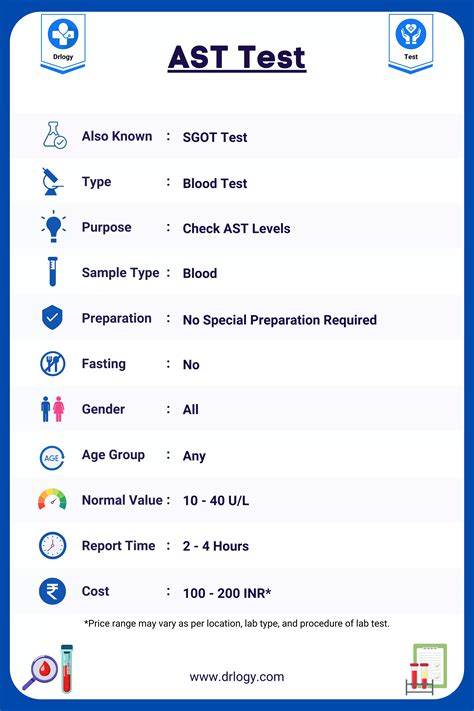The accuracy of an AST lab test, also known as an aspartate aminotransferase test, is crucial for diagnosing and monitoring various liver and muscle conditions. AST is an enzyme found in several parts of the body, including the liver, heart, muscles, and kidneys. When these tissues are damaged, AST is released into the bloodstream, and its levels can be measured through a blood test.
Understanding AST Levels
To comprehend the accuracy of an AST lab test, it’s essential to understand how to interpret the results. The normal range for AST levels in the blood varies slightly among different laboratories but is generally considered to be between 10 to 40 units per liter (U/L). However, what constitutes a “normal” range can vary based on factors such as age, sex, and the specific testing method used.
Elevated AST Levels
Elevated AST levels can indicate liver damage or disease, such as hepatitis, liver cirrhosis, or liver cancer. It can also be elevated in cases of muscle damage or diseases affecting the muscles. The level of elevation can sometimes give clues about the severity or nature of the underlying condition. For instance, severely elevated AST levels (far beyond the normal range) might suggest acute liver damage or extensive muscle injury.
Decreased AST Levels
While less common, decreased AST levels can also occur. This decrease might not always indicate a specific disease but can sometimes be seen in conditions such as vitamin B6 deficiency, since vitamin B6 (pyridoxine) is a cofactor for the AST enzyme.
Factors Affecting Accuracy
Several factors can affect the accuracy of AST lab test results, including:
- Timing of the Test: AST levels can fluctuate over time, especially in acute conditions. Repeated measurements might be necessary for an accurate assessment.
- Specimen Handling: Improper handling of the blood sample, such as exposure to heat or delay in processing, can lead to inaccurate results.
- Interference from Other Conditions: Certain medications, dietary factors, or underlying health conditions can interfere with AST levels or the test’s accuracy.
- Analytical Variability: Different laboratories may use different methods or equipment for testing, which can lead to slight variations in results.
Ensuring Accuracy
To ensure the accuracy of AST lab test results, it’s crucial to:
- Follow Pre-Test Instructions: Adhere to any dietary restrictions, medication adjustments, or other instructions provided by your healthcare provider before the test.
- Use a Reputable Laboratory: Ensure that the test is conducted in a certified laboratory with rigorous quality control measures.
- Consult with a Healthcare Professional: Discuss your results with a healthcare provider who can interpret them in the context of your overall health, medical history, and other diagnostic findings.
Understanding Your Results
When receiving your AST lab test results, consider the following steps to understand them better:
- Discuss with Your Doctor: Your healthcare provider can explain what your results mean in the context of your health and any symptoms you’re experiencing.
- Look for Patterns: If you’ve had multiple tests over time, looking at the pattern of your AST levels can be more informative than a single result.
- Consider Other Tests: AST is often tested alongside other enzymes, such as alanine aminotransferase (ALT), to give a more complete picture of liver health.
- Follow-Up Testing: Depending on your results and clinical presentation, your healthcare provider may recommend follow-up tests to monitor changes in your AST levels or to evaluate for specific conditions.
In conclusion, the accuracy of an AST lab test is dependent on various factors, including the condition of the sample, the testing methodology, and individual health factors. Understanding your results requires considering these factors and interpreting them within the broader context of your health, ideally with the guidance of a healthcare professional.
What does an elevated AST level indicate?
+Elevated AST levels can indicate liver damage or disease, muscle damage, or other conditions affecting these tissues. The degree of elevation can provide clues about the underlying cause.
How are AST levels interpreted?
+AST levels are compared against a normal range, which can vary by laboratory. Levels above this range may indicate tissue damage, while levels below might suggest other conditions or deficiencies.
What factors can affect the accuracy of AST test results?
+Several factors can affect accuracy, including the timing of the test, specimen handling, interference from other conditions, and analytical variability between laboratories.
By understanding these aspects of the AST lab test, individuals can better navigate their health care, especially when it comes to liver and muscle conditions, and work closely with healthcare providers to make informed decisions based on accurate and reliable test results.


